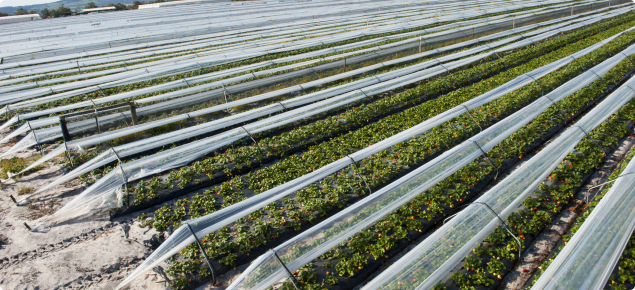Planting
If using four-row beds, plant strawberries in double rows 30 to 40cm apart. Within rows, the plants should be staggered and be from 25cm to 40cm apart, depending on the vigour of the variety and the mechanical aids used.
About 50 000 to 60 000 runners are required to plant one hectare in the Perth region. In southern regions, where inter-row paths are wider, about 40 000 plants are required.
Plant runners as soon as possible after receival, before roots dry out. If planting is delayed, the runners should be cool-stored at 2°C until needed.
A medium-size paint scraper is used to push the plants down into the bed. The method may seem crude but trials have shown it places the plants at no disadvantage. First pierce a hole in the plastic sheet and holding the plants at a 60 degree angle, rest the end of the roots on the plastic. Place the scraper tip close to the ends of the roots, usually 3 or 4cm from the ends, and push down slowly and firmly until the plant crown is level with the surface of the soil. Withdraw the scraper and firm the soil around the plant.
Where plants are being established with overhead irrigation, make larger planting holes (8 to 10cm diameter) to allow good water penetration.
Pruning and cutting
Runners that develop during cropping should be removed as soon as they appear. Runner removal is generally not considered to be worthwhile late in the season.
If an autumn crop is desired, cut bushes to within 2cm of the crowns between March and May in Perth and between May and July in the south and remove all old leaves. Top removal can be aided by slashers, modified lawn mowers, hedge clippers or sharp knives. New growth will emerge quickly, followed by flowers.
Tops should not be removed in hot weather as the crowns can be damaged. If the weather is warm, irrigate regularly after top removal. To reduce disease build-up, rake up all leaves and burn them.
Growers harvest the autumn crop from early April to June, as the autumn crop may be extended into winter with the use of plastic cloches.




